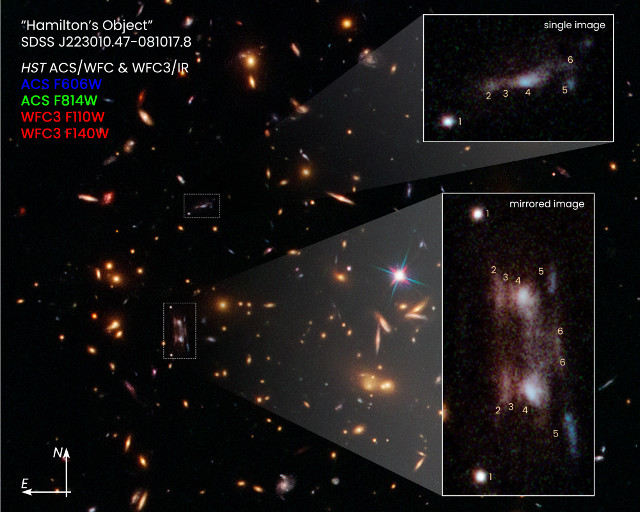
An article published in the journal “The Monthly Notices of the Royal Astronomical Society” reports a solution to an astronomical mystery involving two galaxies that appeared to be mirror images of each other and turned out to be two images of the same galaxy doubled by a gravitational lens. A team of researchers led by Richard Griffiths of the University of Hawaii at Hilo used observations made with the Hubble Space Telescope to obtain enough information to understand the nature of what was named Hamilton’s Object because it was discovered by astronomer Timothy Hamilton. Meanwhile, a third image of the galaxy was discovered, visible in another area of the sky again thanks to the gravitational lens.
In recent years, the effects of gravitational lenses generated by the gravitational distortion of galaxies or galaxy clusters have been thoroughly examined and exploited to obtain more information on very distant galaxies. In various cases, galaxies observed thanks to a gravitational lens would be impossible or at least very difficult to detect with current instruments without that effect.
This understanding of gravitational lenses was much more limited in 2013, when Timothy Hamilton of Shawnee State University at Portsmouth, Ohio, was examining images of quasars and found the one cataloged as AGN SDSS J223010.47-081017.8 and later dubbed Hamilton’s Object. The image looked like that of two interacting galaxies but the data didn’t really fit well.
The turning point for the mystery of Hamilton’s Object came in 2015, when its discoverer showed it to Richard Griffiths at a NASA meeting. Magnified, gravitationally lensed images of galaxies were beginning to become quite common, and Griffiths suggested that possibility confirming it later, when he discovered an image of another similar object in another survey conducted using the Hubble Space Telescope. The image (Richard E. Griffiths (UH Hilo), Jenny Wagner (ZAH)) shows the “copies” of Hamilton’s Object as seen by Hubble.
What generated the gravitational lens was still to be understood. Images from the Sloan Digital Sky Survey indicated that there was a galaxy cluster in the area of the images magnified by the gravitational lens. Spectroscopic measurements made with the Gemini and Keck observatories in Hawaii confirmed that this cluster generated the gravitational lens.
Putting the information together, the team that had formed to study the phenomenon concluded that the galaxy seen in the images was over 11 billion light-years from Earth. Another team studied the galaxy cluster that generates the gravitational lens at the same time, establishing that it’s over 7 billion light-years from Earth.
The effect seen is unusual even for gravitational lenses, and that contributed to delaying the identification of Hamilton’s Object’s nature. It was compared to the effect you can see in a funhouse mirror. Further investigation with the help of Jenny Wagner of the German University of Heidelberg led to a better understanding of the structure of the galaxy cluster examined. The scientist developed, together with her colleague Nicolas Tessore, software to interpret gravitational lenses, and in this case, the conclusion is that dark matter is smoothly distributed around the images in space on a small scale.
In essence, the long research on Hamilton’s Object led to the discovery of a gravitational lens that also offers information that may be useful in dark matter studies. That’s because the smoothness that its distribution can reach has consequences on the possibilities regarding its particles’ mass. The galaxy cluster in which that dark matter was detected offers a new opportunity to test the various models developed to try to solve this cosmological mystery, including alternative ones that deny its existence.

